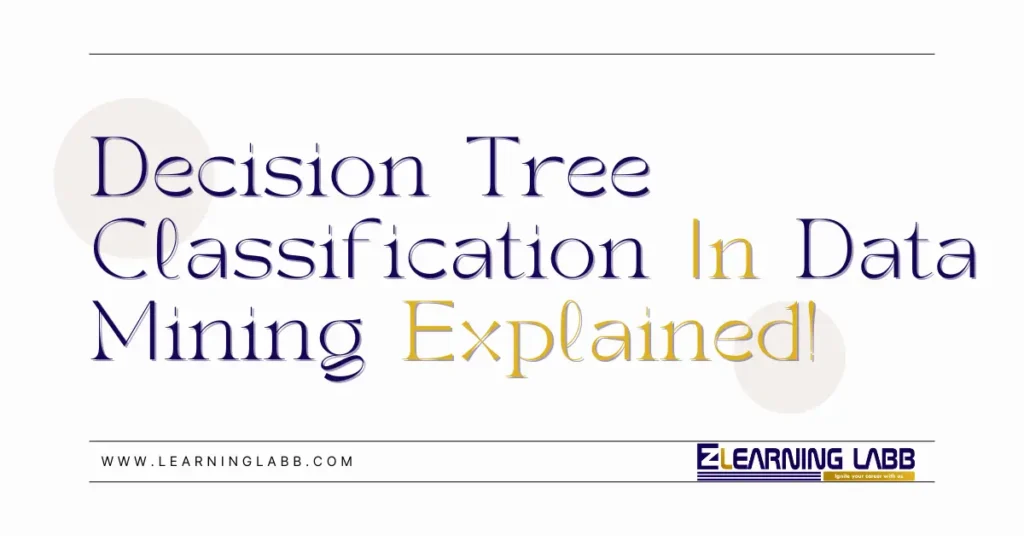Decision Tree Classification In Data Mining: Data mining has revolutionized how organizations make data-driven decisions. Among the most effective tools in this domain is decision tree classification in data mining, which provides a clear and structured way of handling complex datasets. But what makes this technique so special?
Let’s find out here!
What Is a Decision Tree in Data Mining?
Data mining involves extracting useful patterns and insights from large datasets. A decision tree, as the name suggests, is a tree-like structure that classifies data by answering a series of questions. At every stage, decisions are made based on specific attributes, narrowing down the dataset until the desired classification or prediction is achieved.
Whether you’re analyzing customer behavior, predicting disease outcomes, or identifying fraudulent transactions, decision tree classification in data mining is a go-to tool for its simplicity and accuracy.
For example, consider a bank trying to determine whether a loan applicant is likely to default. A decision tree might ask questions like:
- Does the applicant have a stable income?
- What is their credit score?
- How much debt do they already have?
With every “yes” or “no” answer, the tree branches out, narrowing down to a final decision.
How Does Decision Tree Classification Work?
Decision trees use algorithms like ID3, CART, and C4.5 to determine the best way to split the data. These algorithms rely on metrics such as information gain and Gini index to measure the purity of splits. Here’s how the process works:
- Start with the Root Node:
The entire dataset is represented as the root node. - Split the Data Based on Attributes:
The data is split based on a feature (attribute) that provides the highest information gain or lowest impurity. - Branch Out to Sub-Nodes:
Each split creates new nodes, which represent subsets of the data. - Repeat Until Leaf Nodes are Reached:
The process continues until all data points in a subset belong to a single class, resulting in leaf nodes.

Types of Decision Tree
There are several types of decision trees, each suited to different use cases. These include:
- Classification trees: Used for categorical outcomes, such as determining whether an email is spam or not.
- Regression trees: Predict continuous variables, like house prices or stock values.
- Binary trees: Each decision results in two branches.
- Multiway trees: Decisions may result in multiple branches, depending on the attribute’s values.
Characteristics of Decision Tree in Data Mining
To understand why decision tree classification in data mining is so popular, it’s essential to explore its unique characteristics:
- Hierarchical structure: The tree flows from a root node to branches and leaves, representing decisions and outcomes.
- Transparency: Each decision is easy to interpret, making it accessible even for non-technical stakeholders.
- Versatility: Decision trees handle both categorical and numerical data effectively.
- Non-parametric nature: Unlike algorithms like linear regression, decision trees don’t assume a specific data distribution.
Features of Decision Tree
- Simplicity and clarity: Decision trees are intuitive and require minimal preprocessing.
- Recursive splitting: Data is divided recursively until subsets are pure.
- Pruning: Overfitting is avoided by trimming unnecessary branches.
- Missing data handling: Decision trees can handle missing values with ease by using surrogate splits.
Advantages and Disadvantages of Decision Tree
Advantages
- Easy to understand: Decision trees don’t require a statistical background to interpret.
- Scalable: They work well with large datasets.
- Feature importance: Decision trees highlight the most important attributes.
- Nonlinear relationships: They capture complex patterns in data.
Disadvantages
- Overfitting: If not pruned, decision trees may memorize data rather than generalizing.
- Bias in splits: Skewed datasets may lead to biased decisions.
- Computationally expensive: Building large trees can require significant resources.

Importance of Decision Tree in Data Mining
The importance of decision trees cannot be overstated. They provide a simple yet powerful way to classify and predict data. Businesses, medical practitioners, and researchers rely on them to make informed decisions that impact lives and revenue.
For example:
- In business: Decision trees help companies decide which products to recommend to customers.
- In healthcare: They predict disease outcomes and assist in treatment planning.
- In education: Decision trees analyze student performance to identify areas for improvement.
Application of Decision Tree
The real-world applications of decision tree classification in data mining are vast and diverse. Let’s take a look at some examples:
- Fraud detection: Banks use decision trees to flag potentially fraudulent transactions.
- Customer segmentation: Marketers classify customers into segments for targeted campaigns.
- Healthcare diagnosis: Decision trees assist in diagnosing diseases by analyzing symptoms and test results.
- Loan approval: Financial institutions determine loan eligibility based on customer data.
Challenges in Using Decision Trees
While decision trees are powerful, they come with challenges:
- Overfitting: Complex trees may not generalize well to new data.
- Bias in data: Imbalanced datasets can skew results.
- Computational limits: Large trees can become unwieldy and require extensive computational power.
How to Optimize Decision Tree Classification?
To get the most out of decision tree classification:
- Preprocess your data: Ensure clean, balanced data.
- Use pruning techniques: Avoid overfitting by trimming unnecessary branches.
- Combine with ensemble methods: Algorithms like Random Forest enhance accuracy by combining multiple trees.
Why Choose Ze Learning Labb?
For those keen on mastering decision tree classification in data mining, Ze Learning Labb offers courses tailored to both beginners and professionals. The Data Science program covers important topics such as decision trees, helping the students get hands-on experience and theoretical knowledge.
With flexible learning options, including online and offline classes, Ze Learning Labb caters to diverse learning preferences. Moreover, we provide live classes, recorded sessions to support your learning journey. Post-course, ZELL assist with job placements, ensuring you’re not just trained but also get the right support in finding the best suitable job for you.

On A Final Note…
Decision tree classification in data mining serves as a cornerstone technique, offering clarity, interpretability, and versatility. By understanding its structure, types, features, and applications, data enthusiasts can harness its full potential.
As Albert Einstein once said, “If you can’t explain it simply, you don’t understand it well enough.” Decision trees embody this simplicity, making complex data comprehensible.





